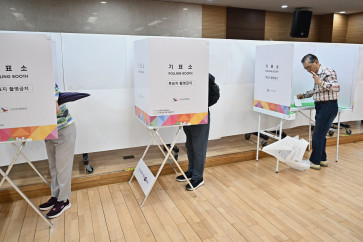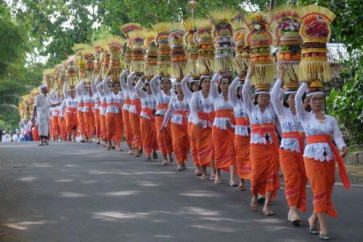Languages that divide; languages that connect, unite
What was the first language that you heard when you were born? Probably that of your parents’ right? I am ethnic Sundanese Indonesian, so you would think that the first language I heard was either Sundanese or Indonesian
Change text size
Gift Premium Articles
to Anyone

W
hat was the first language that you heard when you were born? Probably that of your parents’ right? I am ethnic Sundanese Indonesian, so you would think that the first language I heard was either Sundanese or Indonesian.
Wrong. It probably might have been Hindi, or one of the hundreds of languages that exists in India.
India? Yes, because I was born in New Delhi, delivered by an Indian doctor, and it’s quite possible that he said, “It’s a girl!” in Hindi or English — while slapping my bum to make me cry.
But what is certain is that in my first 20 months of life I was surrounded by a multitude of languages: Indonesian, Sundanese, English and at least a few of the hundreds of languages in India.
Being multilingual continued to be an aspect of my life as a diplomat’s daughter. I learned English at the age of 5 when my parents were posted in London, Hungarian when they were assigned to open the Indonesian Embassy in Budapest, and I learned Italian, French and German when I attended Marymount International High School in Rome as a teenager. I also understand some Dutch as my parents, their friends and my grandparents all spoke Dutch, especially when they didn’t want the kids to understand what they were saying!
So what is my mother tongue? Closest to my heart and mind is English, I have to confess, as it was the medium of instruction at the schools I attended as a child and teenager.
But obviously, Indonesian and Sundanese (the regional languages of the inhabitants of West Java, which make up 15.5 percent of Indonesia’s population) are also close to my heart.
It was not uncommon for our family to mix Indonesian, Sundanese, English and the language of whatever country we were living in at the time. I am grateful to my mother for speaking to me in Sundanese wherever we were, because that is how I learned it, even when I responded to her in another language. Thanks mum, for enhancing my linguistic and cultural diversity.
As Manasa Rao, the Indian author of Love was just a Word, said, “It’s okay to be proud of your good English. But don’t be proud of being poor in your mother tongue. Only the scum of the earth do that.” That’s a bit extreme, but we get your point, Manasa!
Today, Feb. 21, is celebrated as International Mother Language Day (IMLD). It was first announced by UNESCO in November 1999 “to promote awareness of linguistic and cultural diversity and promote multilingualism”.
I just so happen to be in New Delhi at the moment, to speak at an international seminar on cultural, religious and linguistic pluralities. I can think of no better place to be writing about multilingualism than India, except of course Indonesia itself. The country that has the most languages is Papua New Guinea (836), followed by Indonesia (707), Nigeria (529) and India (452).
Being polyglot is actually nothing unusual for an Indonesian, even uneducated Indonesians. In fact it’s more the norm than not. Many people speak their regional language at home, Indonesian among each other and English is commonly used among educated and globalized young Indonesians.
Tamalia Alisjahbana gave a paper on the role language played in the formation of the nation. She is the daughter of Sutan Takdir Alisjahbana, a cultural and literary figure who wrote the first Indonesian language grammar book used in Indonesian schools. As Tamalia pointed out, “Indonesia is unique in that it is one of the few countries in the world that deliberately engineered its own national language and culture.”
Long before independence in 1945, in 1928, a number of young intellectuals already had a vision of a language to fosters Indonesian nationalism. They formulated the Youth Pledge: “One Nation, One People, One Language”. However, their choice of national language was not Javanese, the language of the largest ethnic group, comprising 40.22 percent, but Malay, the lingua franca of the port cities.
This was in order to prevent the cultural domination of the Javanese. If you consider that some of the proponents of the Youth Pledge were Javanese, that’s pretty forward thinking. And that is how Indonesian became the national language.
My fellow panelist, Shyam Saran, former ambassador to Indonesia and former foreign secretary, spoke about the Indian language policy, which was the exact opposite of Indonesia. Due to the multitude of ethnicities and languages in India, the Indians decided not to have a national language.
Instead, their Constitution designates Hindi and English as official languages. Indian states have the freedom to choose their own official language, which resulted in 22 official languages. In fact only between 15 and 25 percent of the Indian population speak Hindi, but Hindi dialects are spoken by about 45 percent of Indians. The use of English is of course because of colonial rule, besides now being the “global language”.
As Navrekha Sharma — also a former Indian ambassador to Indonesia — said, both language policies work in maintaining our respective nation’s unity in diversity: Bhinneka Tunggal Ika in Indonesian (the official motto), and Anekta Mein Ekta in India. This just goes to show that there is more than one way to skin a cat. Or to use a less offensive term for vegetarians, more than one way to peel an orange.
Personally, what concerns me now is the younger generation of Indonesians, at least the urbanites, who may not speak any regional language. I didn’t teach my son Sundanese (yup, guilty as charged!), and he and his wife are not teaching their son, i.e. my 3-year-old grandson Amartya, Indonesian. They speak English to him at home and at school he learns Mandarin. They live in Singapore, but they say that at one point they will send him to Indonesia where a year of immersion will make him fluent. I certainly hope so because language is identity, and I don’t want Amar to lose his Indonesian identity.
As they say, language can be a bridge or a barrier, but for me it’s an amazing door opener to various nations, cultures, people, minds and hearts. So let us foster a national multilingual national policy in our schools!
__________________________________
The writer is the author of Julia’s Jihad. She spoke at a seminar entitled “India and Indonesia: Exploring Cultural, Religious and Linguistic Pluralities and Inclusive Identities”, organized by the India International Centre recently.









